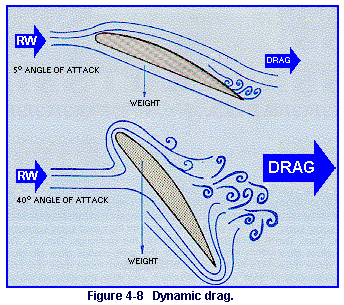 |
|||||
| Home | Research | For Teachers | HISTORY Level 1 Level 2 Level 3 |
PRINCIPLES Level 1 Level 2 Level 3 |
CAREER Level 1 Level 2 Level 3 |
| Gallery | Hot Links | What's New! | |||
| Web Administration and Tools | |||||
 |
|||||
| Home | Research | For Teachers | HISTORY Level 1 Level 2 Level 3 |
PRINCIPLES Level 1 Level 2 Level 3 |
CAREER Level 1 Level 2 Level 3 |
| Gallery | Hot Links | What's New! | |||
| Web Administration and Tools | |||||
![]()
Induced drag is the unavoidable by-product of lift and increases as the angle of attack increases. Remember, the greater the angle of attack, up to a critical angle, the greater the amount of lift developed and the greater the induced drag. Since there are two different ways that lift is produced, there are also two different types of induced drag: dynamic drag (Newtonian) and pressure drag (Bernoulli).

First, let's consider dynamic induced drag, shown in Figure 4-8. If you hold your hand out of the window of a moving car, with the front edge tipped up at an angle to the relative wind to give it an angle of attack, you will feel a force pushing your hand back, but also slightly upward. In other words, depending on the angle of attack, there will be a force backward (induced drag) and a force upward (lift). The amount of force in each direction will depend on the angle of attack. If the angle of attack is small, the drag and lift are comparatively small. Any increase in angle of attack, up to a certain point, will increase drag and lift. However, at very high angles of attack, approaching the stall point, lift will decrease and the drag will overcome lift and thrust with an accompanying loss of speed and attitude. If you were to hold your hand vertical to the relative wind, the only force would be backward; that is, all dynamic drag and no lift.
Now let's consider pressure-induced drag, which can be divided into the two types. You will remember that the thin layer of air over the upper surface of the wing will break away from the wing at high angles of attack and that the flow will become turbulent as the flow of air breaks away from the wing. This turbulence results in pressure drag and loss of lift. Turbulence and pressure drag also result from the flow of air around the wingtip as the comparatively high-pressure air under the wing flows over the wingtip to the low-pressure area on top of the wing.
Send all comments to ![]() aeromaster@eng.fiu.edu
aeromaster@eng.fiu.edu
© 1995-98 ALLSTAR Network. All rights reserved worldwide.
| Funded in part by | From Civil Air Patrol Educational Materials |
Updated: February 23, 1999